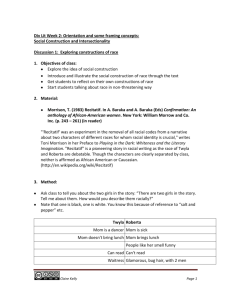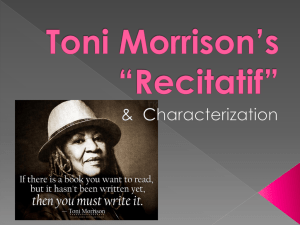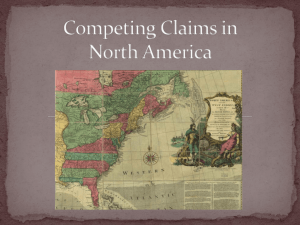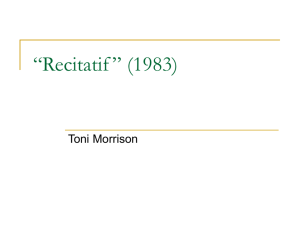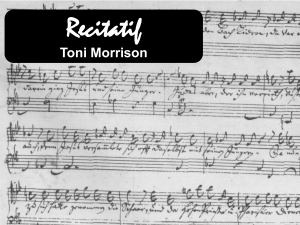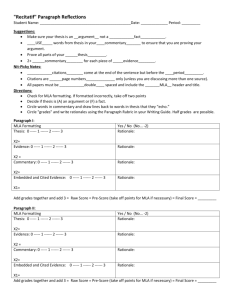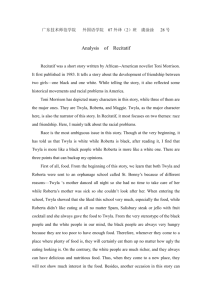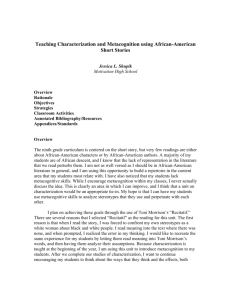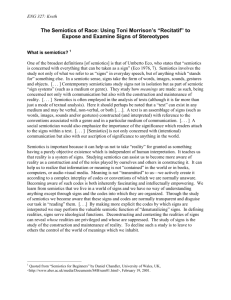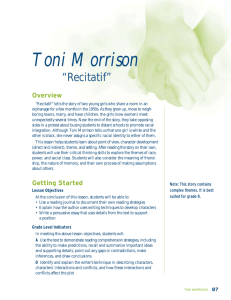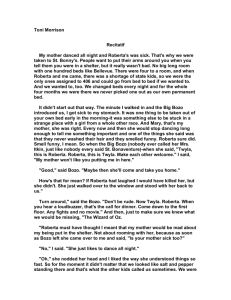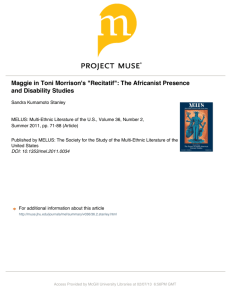Double-Entry Journal - Weekly Homework
advertisement
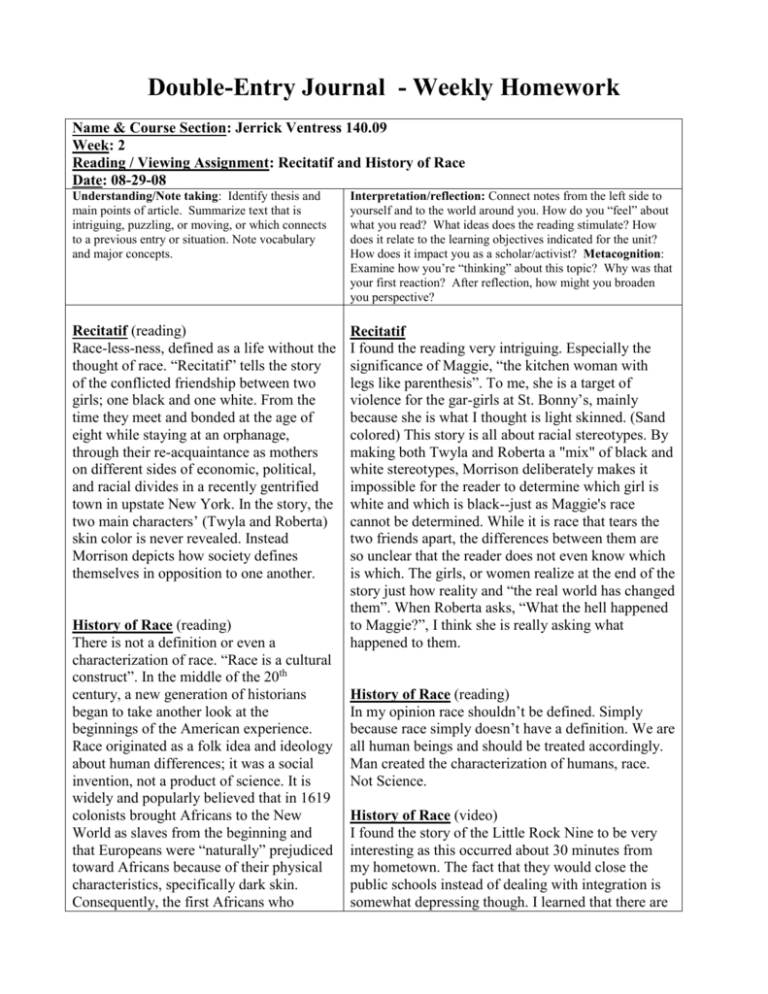
Double-Entry Journal - Weekly Homework Name & Course Section: Jerrick Ventress 140.09 Week: 2 Reading / Viewing Assignment: Recitatif and History of Race Date: 08-29-08 Understanding/Note taking: Identify thesis and main points of article. Summarize text that is intriguing, puzzling, or moving, or which connects to a previous entry or situation. Note vocabulary and major concepts. Interpretation/reflection: Connect notes from the left side to yourself and to the world around you. How do you “feel” about what you read? What ideas does the reading stimulate? How does it relate to the learning objectives indicated for the unit? How does it impact you as a scholar/activist? Metacognition: Examine how you’re “thinking” about this topic? Why was that your first reaction? After reflection, how might you broaden you perspective? Recitatif (reading) Race-less-ness, defined as a life without the thought of race. “Recitatif” tells the story of the conflicted friendship between two girls; one black and one white. From the time they meet and bonded at the age of eight while staying at an orphanage, through their re-acquaintance as mothers on different sides of economic, political, and racial divides in a recently gentrified town in upstate New York. In the story, the two main characters’ (Twyla and Roberta) skin color is never revealed. Instead Morrison depicts how society defines themselves in opposition to one another. Recitatif I found the reading very intriguing. Especially the significance of Maggie, “the kitchen woman with legs like parenthesis”. To me, she is a target of violence for the gar-girls at St. Bonny’s, mainly because she is what I thought is light skinned. (Sand colored) This story is all about racial stereotypes. By making both Twyla and Roberta a "mix" of black and white stereotypes, Morrison deliberately makes it impossible for the reader to determine which girl is white and which is black--just as Maggie's race cannot be determined. While it is race that tears the two friends apart, the differences between them are so unclear that the reader does not even know which is which. The girls, or women realize at the end of the story just how reality and “the real world has changed them”. When Roberta asks, “What the hell happened to Maggie?”, I think she is really asking what happened to them. History of Race (reading) There is not a definition or even a characterization of race. “Race is a cultural construct”. In the middle of the 20th century, a new generation of historians began to take another look at the beginnings of the American experience. Race originated as a folk idea and ideology about human differences; it was a social invention, not a product of science. It is widely and popularly believed that in 1619 colonists brought Africans to the New World as slaves from the beginning and that Europeans were “naturally” prejudiced toward Africans because of their physical characteristics, specifically dark skin. Consequently, the first Africans who History of Race (reading) In my opinion race shouldn’t be defined. Simply because race simply doesn’t have a definition. We are all human beings and should be treated accordingly. Man created the characterization of humans, race. Not Science. History of Race (video) I found the story of the Little Rock Nine to be very interesting as this occurred about 30 minutes from my hometown. The fact that they would close the public schools instead of dealing with integration is somewhat depressing though. I learned that there are arrived in Jamestown were not initially or uniformly perceived as slaves. They were assimilated into the colony as laborers under varying contracts like those of Europeans. Some Africans worked off their debts and became freedmen. Edmund Morgan wrote, “There is more than a little evidence that Virginians during these years were ready to think of Negroes as members or potential member of the community on the same terms as other men. By midcentury, the colony was in a crisis. In 1676, the most famous rebellion took place. Led by Nathaniel Bacon, this uprising of thousand of poor workers was the first major threat to social stability. The rebellion dissipated after the death of bacon, but they soon recognized the need for a stratagem to prevent such occurrences in the future. The decisions that the rulers of the colony made during the last decades of the 17th century and the first quarter of the 18th century resulted in the establishment of racial slavery. There were critical reasons for the preference for Africans. As early as the 1630s, planters had expressed a desire for African laborers. The often wrote, “We cannot survive without Africans!” History of Race (video) Court cases such as Brown v. Board of Education and Plessy v. Ferguson helped abolish racism throughout the U.S. Congress enacted two significant measures that, initially, were designed to overturn race-based discrimination against blacks. The first was the Civil Rights Act of 1964, which barred discrimination in public facilities and employment, and the second was the Voting Rights Act, barring practices aimed at disenfranchising black voters. These Acts and Court Cases helped bring to an end instances such as the Little Rock Nine had to encounter. When the Little Rock school board voted to integrate their school system in 1957, the decision still some public school, especially in suburban areas, that are still segregated. was not expected to meet much resistance. The situation turned into a crisis, however, when the Little Rock Nine, the nine African American students who integrated Central High, attempted to enroll in September of that year. Arkansas Governor Orval Faubus called upon the National Guard to prevent them. The students again tried and failed to attend later that month. The following day President Dwight Eisenhower deployed troops from the 101st Airborne to Little Rock to protect the students, who were admitted, but endured a year of physical and verbal abuse. Little Rock then took their final option to avoid integration, and closed its public schools the next year, 1958.
